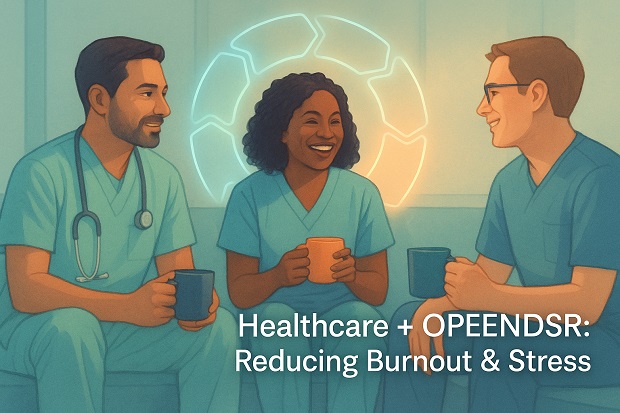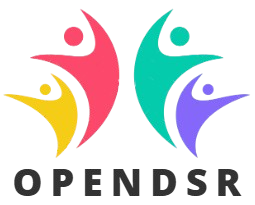
Applying OPENDSR in Healthcare: Reducing Burnout & Stress
Why Burnout is the Healthcare Crisis We Don’t Talk About Enough
The world applauds healthcare workers as heroes. From doctors and nurses to technicians, aides, and administrative staff—the healthcare workforce carries the burden of saving lives, often at great personal cost. Behind the applause, however, lies a troubling reality: burnout and stress have reached critical levels.
According to the World Health Organization, burnout is now officially classified as an occupational phenomenon, characterized by exhaustion, cynicism, and reduced professional efficacy. Studies show that nearly half of healthcare professionals report feeling burnt out at some point in their careers. This isn’t just a personal issue—it affects patient care, safety, and the very sustainability of healthcare systems.
The question is: What can organizations do differently to protect the wellbeing of their staff without compromising care?
This is where OPENDSR comes in.
OPENDSR: A Human-Centered Framework for Healthcare
OPENDSR—short for Operating Principles for Employee Experience & Network Design with Standards & Real-time Intelligence—is not another rigid HR tool. It’s a structured, empathy-led operating cycle that helps organizations continuously observe, prioritize, design, and refine the real experiences of their people.
At its heart are four guiding pillars:
- Open Platform – Use existing systems (EMR, HRIS, Slack/Teams) instead of layering new burdensome tools.
- Empathy-led Navigation – Deeply understand frontline experiences—not assumptions.
- Design Standards – Build clear, repeatable, inclusive ways of working.
- Real-time Intelligence – Capture friction as it happens and respond immediately.
And a 7-step operating cycle:
Observe 👀 → Prioritize 🎯 → Envision 🧠 → Navigate 🗺️ → Design ✏️ → Systematize ⚙️ → Refine 🔄
For healthcare, this cycle offers a practical playbook to address stress, reduce friction, and restore wellbeing.
Why Healthcare Needs OPENDSR Now
Unlike many industries, healthcare has unique stress multipliers:
- Emotional labor: Dealing with patient suffering and loss daily.
- High-stakes decision-making: Split-second choices affect lives.
- Staffing shortages: Nurses and doctors stretched to unsafe levels.
- Rigid systems: Outdated processes and compliance-heavy workflows.
- Emotional isolation: Limited safe spaces for reflection and recovery.
Traditional HR surveys or wellbeing apps don’t go deep enough. OPENDSR bridges the gap between policy and lived experience—helping organizations build real support structures around their teams.
Applying the OPENDSR Cycle in Healthcare
Let’s walk through how each step can reduce burnout in a healthcare setting.
1. Observe – Listening Beyond Metrics
Healthcare staff often say: “We fill out surveys, but nothing changes.”
With OPENDSR, observation moves beyond annual surveys. Instead, teams use pulse listening (weekly 2–3 questions), open forums, and real-time feedback channels integrated into existing platforms like Teams or EMR systems.
For example:
- A nurse quickly flags: “Shift handovers feel rushed—we miss critical patient notes.”
- A technician reports: “Equipment downtime adds pressure on my shift.”
These aren’t abstract complaints—they are live friction points that cause stress daily.
2. Prioritize – Focusing on What Hurts Most
Not all problems can be solved at once. OPENDSR teaches organizations to prioritize the issues with the highest impact on wellbeing and patient care.
For instance:
- Instead of fixing cafeteria food first, leadership focuses on reducing unsafe overtime or improving shift handovers.
- Teams rank issues collectively, ensuring staff feel heard in deciding what matters most.
This shared prioritization builds trust and ensures energy goes where it counts.
3. Envision – Co-Creating Healthier Experiences
Burnout reduction requires reimagining the workday. Using empathy mapping and co-creation workshops, healthcare teams envision what “good” looks like.
Example envisioning session:
- Current reality: “I don’t even have 10 minutes for a meal.”
- Envisioned experience: “Protected micro-breaks built into the schedule, with peer coverage.”
This process validates staff voices and builds realistic, context-aware solutions.
4. Navigate – Building the Plan
Envisioning is inspiring, but execution needs a navigation map.
In healthcare, this could look like:
- Assigning responsibility (HR + Nursing Manager)
- Mapping timelines (“Pilot new shift handover template in 2 weeks”)
- Allocating resources (extra float nurse for coverage)
- Communicating milestones (“Trial feedback by end of month”)
This step ensures burnout solutions are not “HR’s problem” alone but co-owned across leadership, managers, and teams.
5. Design – Embedding Standards
Here’s where change sticks.
Design standards provide consistency across units, preventing burnout from creeping back due to uneven practices.
Example standards:
- Shift Handover Template – clear, repeatable, used everywhere.
- Break Protocols – 10-minute protected breaks every 4 hours.
- Wellbeing Check-ins – structured weekly debrief for high-stress departments.
These standards reduce cognitive load, ensuring staff aren’t re-negotiating survival tactics daily.
6. Systematize – Embedding in Workflows
Great ideas often die when they remain optional. Systematization makes burnout-reducing practices part of the daily workflow.
Examples:
- HRIS automatically flags when a nurse is booked for unsafe overtime.
- Calendar reminders ensure managers conduct wellbeing check-ins.
- Digital dashboards show shift coverage and break adherence in real-time.
By embedding changes into systems and routines, burnout prevention becomes sustainable.
7. Refine – Continuous Learning
Healthcare is dynamic—new stressors emerge constantly. OPENDSR emphasizes quarterly reflection:
- What worked? → “New handover sheets reduced errors.”
- What didn’t? → “Staff still skip breaks on busy days.”
- What next? → “Assign on-call float staff to cover breaks.”
This loop ensures solutions evolve with reality, rather than becoming stale policies.
Real-World Use Cases of OPENDSR in Healthcare
Case 1: Reducing Nurse Burnout in a City Hospital
Challenge: Nurses reported exhaustion from inconsistent breaks and constant overtime.
OPENDSR in Action:
- Observe: Real-time feedback exposed “no breaks” as top friction.
- Prioritize: Leadership focused on micro-breaks before cafeteria upgrades.
- Envision: Nurses co-created “10-minute buddy coverage.”
- Design: Break protocol standardized across wards.
- Systematize: Scheduling system enforced coverage rotation.
Impact: Staff satisfaction rose by 32%, overtime decreased by 18%.
Case 2: Emotional Debriefs for Emergency Teams
Challenge: ER staff faced trauma exposure without safe outlets.
OPENDSR in Action:
- Weekly structured debriefs introduced.
- Confidential peer circles normalized.
- Real-time dashboards tracked attendance and sentiment.
Impact: 40% reduction in reported emotional exhaustion within 6 months.
Case 3: Reducing Administrative Burden
Challenge: Doctors frustrated with repetitive paperwork.
OPENDSR in Action:
- Observations revealed duplication in reporting.
- Prioritized “paperwork simplification” over less urgent concerns.
- Standardized templates + digital automation.
Impact: 2 hours per doctor freed daily → better patient time, less stress.
For Staff
- Heard: Feedback leads to visible action.
- Supported: Stressors addressed before crisis.
- Clarity: Consistent standards reduce uncertainty.
For Organizations
- Retention: Lower burnout = fewer resignations.
- Patient Safety: Clearer handovers, better-rested staff.
- Efficiency: Systematized workflows cut wasted effort.
Healthcare doesn’t need more red tape. OPENDSR keeps governance light but clear:
- Roles: EX steward, wellbeing officer, clinical leader.
- Reviews: Quarterly trust-building reflection.
- Metrics: Focused on sentiment, friction, and flow—not vanity KPIs.
Applying OPENDSR in healthcare isn’t about grand policies—it’s about practical human moments:
- One better handover.
- One protected break.
- One safe emotional debrief.
When repeated and refined, these moments build a culture where burnout is not inevitable—but preventable.
Healthcare deserves better. Patients deserve better. And with OPENDSR, organizations finally have a clear, empathetic, structured way forward.








